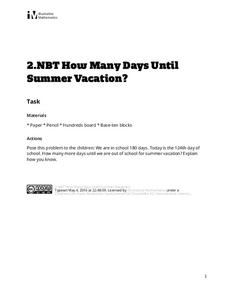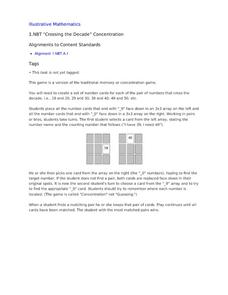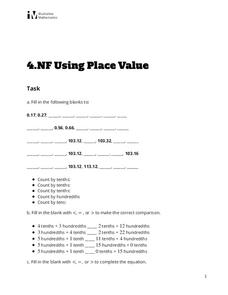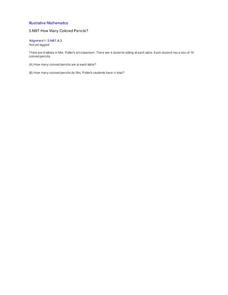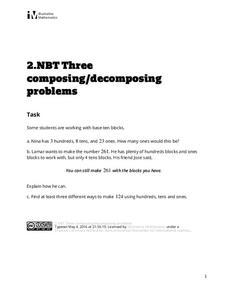Illustrative Mathematics
Counting by Tens
With this daily counting activity, your kindergartners will master counting in sequence automatically from 0 to 100, and will count in multiples of ten to 100. With the whole class, count to 100. With each number, learners will whisper...
Curated OER
Choral Counting I
Using a 100s chart or a number line with a pointer, work with your class to count up to 100 by ones and tens. As a part of daily instruction, prompt your kindergartners to chant count from 1 to 30. Move on to 1 to 50, and then from 1 to...
Illustrative Mathematics
How Many Days Until Summer Vacation?
On the 124th day of school, young mathematicians are asked to find out how many days are left in the 180-day school year. The teacher version to the task offers several ways the problem can be solved, and can be used to guide instruction...
Illustrative Mathematics
Assessing Counting Sequences Part I
Working with kindergartners one-on-one, you will identify their ability to count by 1s and 10s and conclude what levels they have mastered, as well as where they need skills practice and instruction. The commentary provided will aid you...
Curated OER
Counting Circles
Here is another learning game that will engage your kindergartners and support them with their counting fluency. Forming a circle where everyone faces inward, choose a counting sequence (counting frontward or backward) with no more than...
Curated OER
Number Rods
Working in a math center or an "I finished early" work station, young mathematicians will match in sequence pre-set-up rods of unifix cubes to numbers on a number line. To help differentiate tens from ones, use different colors to...
Curated OER
Pick a Number, Counting On
This is a quick learning game that can be played on a daily basis during transitions or as a part of the morning meeting. Using number cards or numbers placed on sticks, pick a number at random. Read the number to the class and then ask...
Illustrative Mathematics
Counting Stamps
Stamps come in sheets, strips, and singles. Young mathematicians use their knowledge of hundreds, tens, and ones to determine how many stamps Mike has altogether.
Illustrative Mathematics
“Crossing the Decade” Concentration
Young mathematicians concentrate on learning to fluently count. Following the rules of the classic game Memory, children take turns flipping over cards in order to find pairs of numbers that cross a decade (e.g. 29 and 30). For younger...
Illustrative Mathematics
Using Place Value
Learners count by tenths, hundredths, or tens in a task that uses decimal place value strategies. The young mathematicians then use <, >, or = to make correct comparisons between expanded decimal notations.
Los Angeles County Office of Education
Assessment for the California Mathematics Standards Grade 1
Here is an assessment designed to test mathematicians' knowledge of writing numbers, comparing numbers, skip counting, solving addition and subtraction problems; along with measuring objects, telling time, identifying shapes, reading...
Illustrative Mathematics
Hundred Chart Digit Game
Math games, especially in the primary grades, provide great opportunities for developing the number sense of young mathematicians. Working in pairs with a deck of single-digit cards, students take turns drawing two cards and reading the...
Illustrative Mathematics
How Many Colored Pencils?
Support young mathematicians' interpretation of place value in order to multiply single-digit numbers by 10. The task builds upon and enhances a learners' understanding of place value, a second grade skill, while introducing them to...
Illustrative Mathematics
Party Favors
Pia is putting stickers into party bags. She starts by putting 10 stickers in each bag, and over the course of a week she adds several bundles of ten stickers to each bag, as well as making more bags. Second graders must find the number...
Illustrative Mathematics
Making 124
How many ways can you make the number 124 using only tens and ones? Use a task that prompts young mathematicians to make 124 in as many ways as possible.
Illustrative Mathematics
Three Composing/Decomposing Problems
Practice composing and decomposing numbers in base-ten using three word problems. Each problem presents a different scenario requiring learners to explain their thinking, find the number of ones, and find out different ways to make a...
Illustrative Mathematics
Boxes and Cartons of Pencils
Boxes and cartons of pencils are a natural, real-world example for understanding bundles of ten and their relationship to a hundred. When you have many cartons, you can discuss place value, and how to represent multiple hundreds.
EngageNY
Real-World Positive and Negative Numbers and Zero
Class members investigate how positive and negative numbers are useful in the real world. Individuals first read a short passage and identify terms indicating positive and negative numbers. They consider situations involving positive...
Other popular searches
- Skip Counting by Tens
- Counting Hundreds Tens Ones
- Math Counting by Tens
- Counting Tens and Ones
- Counting by Tens Chart
- Food Counting by Tens
- Counting in Tens Worksheet
- Counting With Tens and Ones




